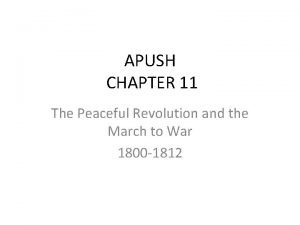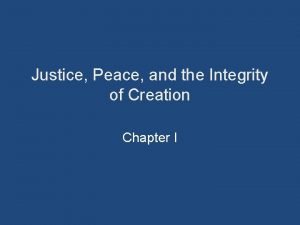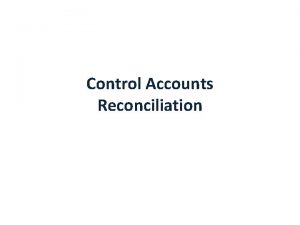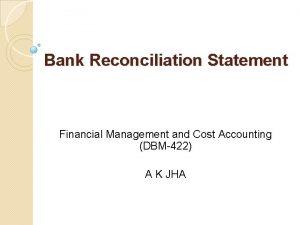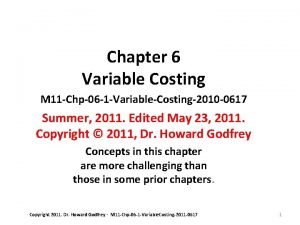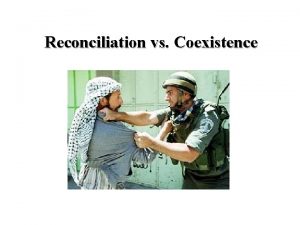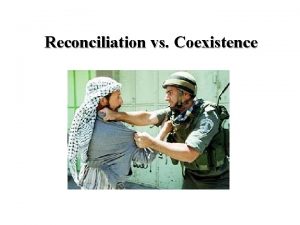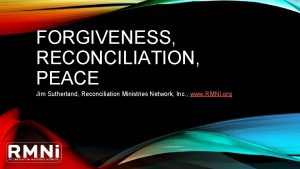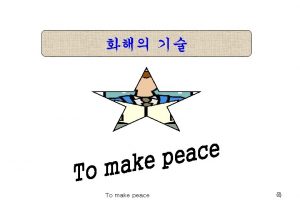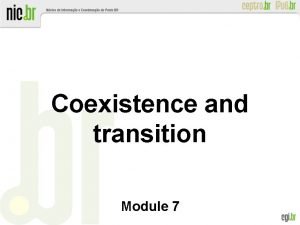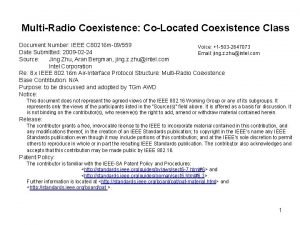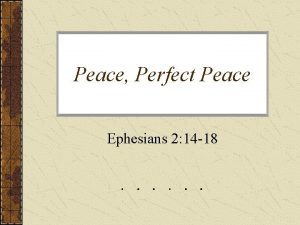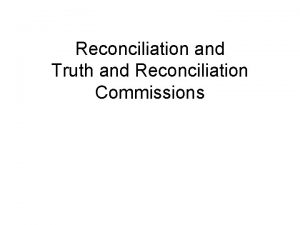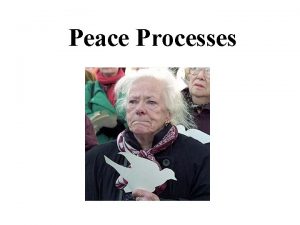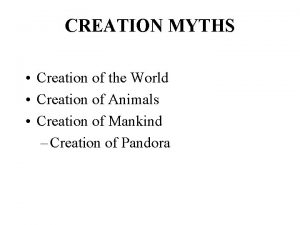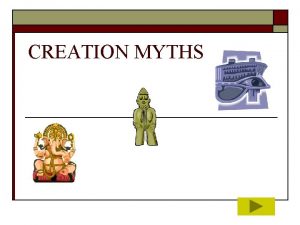Reconciliation vs Coexistence Peace Creation and maintenance of




















- Slides: 20

Reconciliation vs. Coexistence

Peace: Creation and maintenance of relationship of proven value and worth

There is a relationship involved in all states of peace. • Separative Peace • Associative Peace • Restorative Peace

Coexistence Instable Coercion Integration

Coexistence: • It reflects an accommodation between members of different communities or separate countries who live together without trying to destroy or severely harm the other. • Often, coexistence can involve competition and conflict if conducted through legitimate channels, as well as differences in values, cultural patterns, economic standing and political power. • It is based on a sense of mutual tolerance and even respect.

Psychological Prerequisites for Mutual Acceptance (Kelman): 1. Both side had to acquire insight into each other’s perspective so that they could understand the resistance to acceptance. 2. Each side had to see that there were reasonable people on the other side and that there were issues to talk about, rather than that the two sets of demands were mutually exclusive. 3. Each side had to distinguish the ideological dreams and rhetoric from the operational programs of the other. Israel had to be persuaded that the Palestine dream of a united Palestine did not preclude the acceptance of the State of Israel and a stable peace with it. Palestinians had to be persuaded that the Zionist dream of the ingathering of exiles did not necessitate expansionist policies of annexation and settlement. 4. Both sides had to see that mutual concessions could bring about change leading toward resolution. 5. Each side had to believe that leadership changes conducive to a stable peace could take place in the other side. Israelis had to be convinced that the PLO was becoming a political organization (as opposed to terrorist one). Palestinians had to be convinced that the hardline politics of the current Israeli government could become more conciliatory. 6. Each side had to see responsiveness to its human psychological needs by the other side through symbolic gestures.

Approaches to Conflict Resolution/Reduction 1. Conflict Management 2. Conflict Resolution 3. Conflict Transformation

What is Reconciliation? 1. Truth 2. Justice 3. Forgiveness/remorse 4. Safety/Security

The Foundations of Political Life Unpredictability Ability to make promises 2. Irreversibility Ability to forgive Hannah Arendt The Human Condition

“Without being forgiven, released from the consequences of what we have done, our capacity to act would, as it were, be confined to one single deed from which we could never recover; we would remain the victims of its consequences forever, not unlike the sorcerer’s apprentice who lacked the magic formula to break the spell. ”

“Without being bound to the fulfillment of promises, we would never be able to keep our identities; we would be condemned to wander helplessly and without direction in the darkness of each man’s lonely heart, caught in its contradictions and equivocalities – a darkness which only the light shed over the public realm through the presence of others, who confirm the identity between the one who promises and the one who fulfills, can dispel. ”

Definition of Trust: belief in, and willingness to act on the basic of, the words, actions, and decisions of another Trust has relevance only to situations in which there exists some degree of uncertainty or risk.

The Paradox of Trust: You need trust to develop trust.

Rousseau: Development of Civil Society Common Knowledge Player B Player A C D C 4, 4 1, 3 D 3, 1 2, 2

Trust/Distrust Trust: Confident positive expectations Distrust: Confident negative expectations All relationship are degrees of trust and distrust: CBT, CBD, IBT. &IBD. Creating trust in a relationship is initially a matter of building CBT

Actions that build CBT We tend to see people who act consistently and reliably as credible and trustworthy. 1. Behave in appropriate and consistent ways 2. Meet deadlines 3. Perform task and follow through with planned activities as promised

Strategies to manage CBD (1) Agree explicitly on expectations – tasks, deadlines, penalties, etc. (2) Agree on monitoring and verification procedures (3) Cultivate alternative ways to have one’s need met (4) Increase the other’s awareness of how their performance is perceived Example: Decommissioning in Northern Ireland

Actions that build IBT (1) Spend time sharing (2) Common interests (3) Common goals and objectives (4) Similar reactions to common situations (a) Situations where they stand for the same values and principles, thereby demonstrating integrity (5) Find ways to demonstrate that you have the interests of the other at heart (6) We are likely to build IBT only with those whom we feel we legitimately share goals, interests, perceptions and values and if we meet under circumstance that facilitate our learning about this similarity.

Strategies to manage IBD (1) To develop sufficient CBT so that the parties with straightforward behavioral expectations that each has about the relationship (2) Opening acknowledge areas of mutual distrust and design safeguards (3) Design ways to keep IBD issues form interfering with ability to work together

When is reconciliation an appropriate framework? When you can’t get what you want without the help of the other.
 The coexistence of good and evil
The coexistence of good and evil A peaceful revolution apush
A peaceful revolution apush Coexistence
Coexistence Migration whiz
Migration whiz Bittitan coexistence
Bittitan coexistence Integrity of creation reflection
Integrity of creation reflection What is integrity of creation
What is integrity of creation Intelligence creation and use and bi governance
Intelligence creation and use and bi governance Scouriging
Scouriging Marginal cost format
Marginal cost format Control account reconciliations
Control account reconciliations Cost accounting reconciliation statement
Cost accounting reconciliation statement Division reconciliation and expansion
Division reconciliation and expansion Reconciliation of variable and absorption costing
Reconciliation of variable and absorption costing Verily in the creation of the heavens and earth
Verily in the creation of the heavens and earth Trade diversion and trade creation
Trade diversion and trade creation Umich
Umich Which is the most enduring free trade area in the world?
Which is the most enduring free trade area in the world? Creation of goods and services
Creation of goods and services Money supply and credit creation
Money supply and credit creation Knowledge creation and knowledge architecture
Knowledge creation and knowledge architecture

